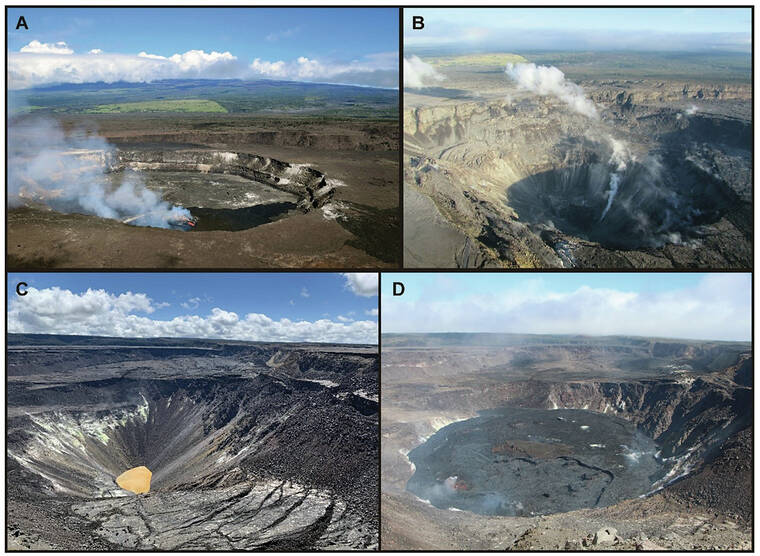May 3 marked the fourth anniversary of the start of Kilauea’s historic 2018 eruption that covered much of lower Puna with lava flows and dropped the crater floor of the summit. This anniversary is an appropriate time to reflect on the dynamic landscape we share and the events of the past 4 years. At the same time, we’re considering what these recent changes might mean for future activity at Kilauea.
For some, Kilauea Volcano seemed set in its ways, as it had been erupting for 35 years (1983–2018) at Pu‘u‘o‘o on the middle East Rift Zone. The summit crater of Halema‘uma‘u joined the action, and from 2008 to 2018 hosted a lava lake that drew people from around the world to enjoy its stunning views.
While seismographs, tiltmeters, and various other geophysical equipment were recording the beginning of changes at Kilauea in 2018, the first major visible sign of something out of the ordinary occurred on April 30 with the sudden collapse at Pu‘u‘o‘o. Just a few days later, on May 3, seismic activity had migrated beneath Leilani Estates and fissures opened. Before May was over, 24 fissures had erupted and lava flows would continue to inundate parts of lower Puna until September.
The summit crater of Halema‘uma‘u also underwent major change, and its lava lake disappeared during the 2018 eruption. As lava flows in lower Puna drained the summit magma reservoir, Halema‘uma‘u underwent 62 collapses (some with explosive eruptions). Each incremental collapse was marked by earthquakes that were felt throughout the summit. When the dust settled (and there was a lot of dust), the collapses had lowered the crater floor by more than 500 m (1,600 ft).
The end of the 2018 eruption and caldera collapse events brought a period of quiescence that had been unknown at Kilauea for over 35 years. It also brought a new and interesting change to the volcano.
For the first time since written records began, a water lake formed within the deepened pit of Halema‘uma‘u. First noticed in July 2019, the water continued to slowly fill the crater over the next year and a half until it was about 50 m (160 ft) deep.
On the night of Dec. 20, 2020, the water lake boiled away within an hour or two as Halema‘uma‘u burst into eruption again. Within less than a day the new lava lake was deeper than the water lake had been, and it continued to grow and fill in the crater until May 2021. Yet again, Kilauea did not stay quiet for long. Halema‘uma‘u began a new eruption in September 2021; an eruption that continues to this day. These two eruptions have filled Halema‘uma‘u with over 320 m (1,050 ft) of lava.
Nearly continuous lava lake activity occurred for decades at Kilauea’s summit in the 19th century. While the summit eruption within Halema‘uma‘u doesn’t currently show signs of stopping, it can be easy to forget that Kilauea has the potential to change quickly from one day to the next. Just glancing at the volcanic rocks, ash, and vegetation, or lack thereof, on Kilauea testifies to inevitable events that can sometimes happen with remarkable speed over the course of months, weeks, or even days.
An important question on the minds of USGS Hawaiian Volcano Observatory staff is what these recent changes portend for Kilauea’s future? The appearance of the water lake at the summit in 2019 renewed attention on Kilauea’s explosive potential. Native Hawaiians recorded Kilauea’s major explosive events in their oral traditions and the possibility of explosive eruptions had everyone’s attention during this time. The dramatic switch to summit lava lake activity within Halema‘uma‘u, has alleviated much of that concern.
Are we returning to a period of prolonged summit activity similar to the 1800s? Or will future activity be more similar to that in the three decades prior to the start of the Pu‘u‘o‘o eruption? This period was marked by numerous small and short-lived periodic eruptions that alternated between Kilauea’s summit and rift zones.
It is not possible to know what exactly lies in store for Kilauea’s future, though history and modern monitoring tools provide clues. While this volcanic environment can be dangerous, devastating, and tragic to behold, it is also inspiring, breathtaking, and commanding. With every change, we learn something new and hope to continue to increase our understanding of Kilauea.
Volcano
activity updates
Kilauea volcano is erupting. Its USGS Volcano Alert level is at WATCH. Kilauea updates are issued daily.
Over the past week, lava has continued to erupt from the western vent within Halema‘uma‘u crater. All lava is confined within Halema‘uma‘u crater in Hawaii Volcanoes National Park. Sulfur dioxide emission rates remain elevated and were last measured at approximately 2,600 tonnes per day (t/d) on May 4. Seismicity is elevated but stable, with few earthquakes and ongoing volcanic tremor.
Summit tiltmeters show one minor inflation and deflation trend over the past week.
Mauna Loa is not erupting and remains at Volcano Alert Level ADVISORY. This alert level does not mean that an eruption is imminent or that progression to an eruption from the current level of unrest is certain.
This past week, about 62 small-magnitude earthquakes were recorded below the summit and upper elevation flanks of Mauna Loa — the majority of these occurred at shallow depths less than 15 kilometers (9 miles) below sea level.
Global Positioning System measurements show low rates of ground deformation over the past week.
Gas concentrations and fumarole temperatures at both the summit and at Sulphur Cone on the Southwest Rift Zone have remained stable over the past week. Webcams show no changes to the landscape.
Two earthquakes were reported felt in the Hawaiian Islands during the past week: a M3.1 earthquake 9 km (5 mi) E of Pahala at 31 km (19 mi) depth on May 3 at 5:41 a.m. HST and a M3.0 earthquake 10 km (6 mi) N of Volcano at 20 km (12 mi) depth on April 30 at 11:07 a.m. HST.
Email questions to askHVO@usgs.gov.



